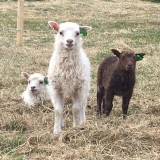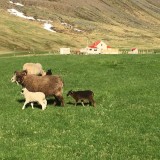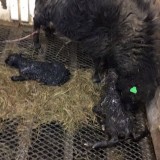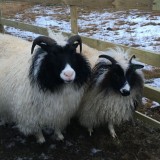About us
This project is a collaboration between the Nature Institute of the Westfjords, the "Farm Food Direct" – association (Beint frá Býli), the company Iceland fish export, a farm in Húsavík and a farm in Gemlufall in Westfjords and Snerpa (a telecommunications service provider). The project was funded by the development fund of the Westfjords in 2014 to get the project started.
We want consumer to be able to see where their meat originates and what steps it has gone through on the way to you. You as the consumer can then choose from which farm you would like your meat and decide what taste you prefer, since the pasture influences the taste of the lamb meat.
Traceability
With your smart phone and a scanner app, scan the QR code on the pack of meat, or enter the number on the product label to learn about the origin of the meat. The products made from sheep are sold in stores and restaurants around the country. Trace your meat with the label as it can be seen here on the left. | |
The sheep farms send their meat to a slaughterhouse where it is processed, or sometimes the farmers even process it themselves. The slaughterhouses that are part of this project are SAH Afurðir in Blönduós and KVH in Hvammstangi. | |
Customers can find out where the lamb is from and see what makes this meat so special. You find the participating farms under Sheep Farms. | |
The natural, foraging lifestyle of the sheep and the influence of their environment create defined flavours in the meat. The grazing land with its different plants and herbs has been mapped so that we know the ratio of different vegetation types. This allows the customer to choose their meat accordingly. If you like to find a taste of heather and berries you should choose a meat from an area with a high proportion of heaths.
Moss heath (Moslendi) Racomitrum heath (Mosagróður) Mosses account for more than half of all vegetation cover in Iceland and are particularly dominant in areas where there is little soil and growing conditions are unfavourable. Moss heath is common both in lava fields and at higher altitudes, where vascular plant growth is generally sparse. Athelia heath (Hélumosagróður) Snowbed vegetation is found in hollows and depressions where snow collects in winter and takes a long time to melt, meaning that the growing season is very short. The most common vascular plants to grow in snowbeds are dwarf alpine willow (Salix herbacea), alpine arctic cudweed (Omalotheca supine), creeping sibbaldia (Sibbaldia procumbens), alpine willowherb (Epilobium anagallidifolium),alpine speedwell (Veronica alpina), hare's-foot sedge (Carex lachenalii) and mossy mountain-heather (Harrimanella hypnoides). A number of the hardiest grassland species also grow in snowbeds. The most common moss species are Racomitrium spp. and Polytrichum sexangulare. Anthelia liverworts are also common in snowbeds, where they are sometimes the dominant species, forming a continuouslight grey carpet on the ground.
Heathland (Mólendi) Heathland is dry and often hummocky, although hummocks can vary somewhat in size. A number of vascular plant species types can be dominant on heathland, for example grasses, heathers or dwarf shrubs. Ericaceous shrubs heath (lyngmói)
Betula nana heath (fjalldrapamói)
Salix spp. heath (víðimói)
Kobresia myosuroides and Juncus trifidus heathland (þursaskeggs og sefmói)
Carex spp. heath (starmói)
Lichens ad dwarf shrub heaths (fléttumói)
Grassland and formb meadows (Gras og blómlendi) Grassland (valllendi) Forb meadows and grasslands tend to be species-rich; dicots and grasses account for most plant life. This type of vegetation grows where the soil is fertile and sufficientlydamp. In Iceland, such conditions are mainly found in hollows and depressions on sunny hillsides where vegetation is protected by snow over the winter.
Dune grassland (melgresi)
Salt meadows (sjávarfitjungur)
Snow-bed grassland (finnungur) |






























